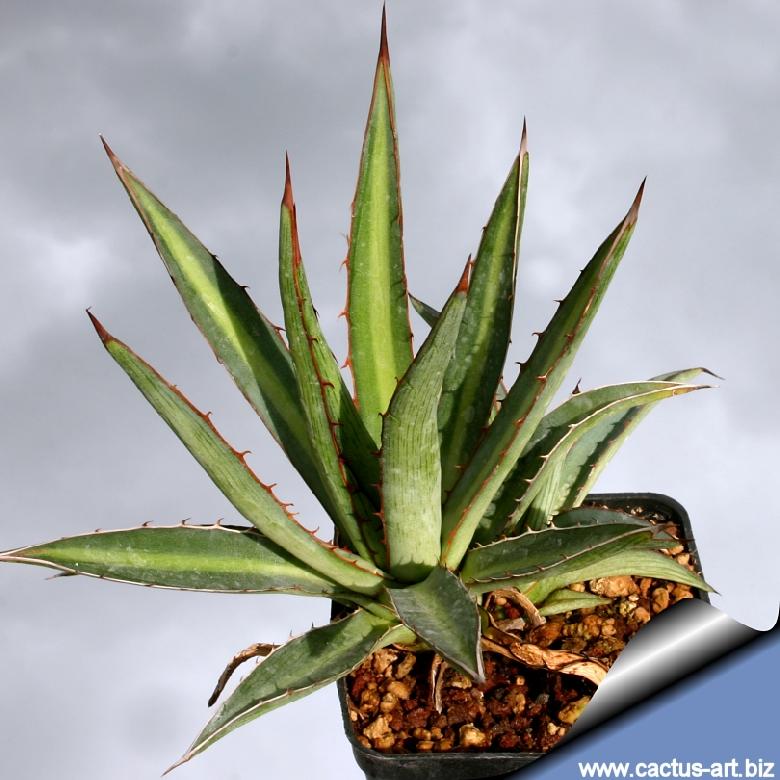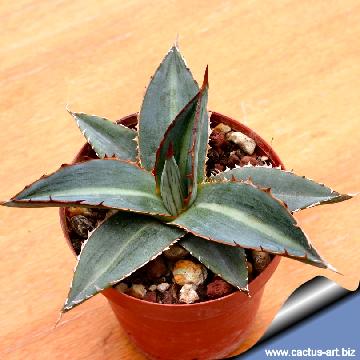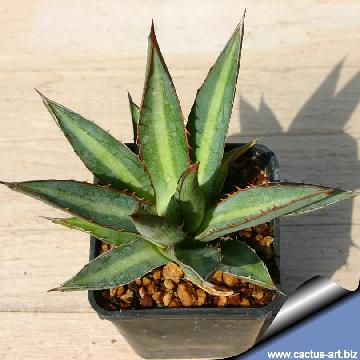
Agave funkiana ( Ixtle de Jaumave )
This species have very ornamental banded and stripped leaves with contrasting reddish teeth.
Origin and Habitat: San Luis Potosi & Hidalgo, Mexico
Habitat: Grows on coarse limestone rocky soils, in the arid side of the sierra Madre Oriental. 1500-1900 m of altitude.
Synonyms:
Common Names include:
ESTONIAN (Eesti): Funki agaav
RUSSIAN (Русский): Агава Функа
SPANISH (Español): Ixtle de Jaumave
Description: It is a rather vigorous, but variable sukering species. The rosettes are, succulent, open spaced, subacaulescent 45 to 150 cm in diameter and tall.
Leaves: 40-80 cm long, 3-6 cm wide. Polymorphic, long-ensiform, straight or falcate or sinuous, stiffly ascending, pale blue to grey-green. Each leaf characteristically have a broad creamy-green band down the centre of the adaxial part (upper surface) of each leaf and dark green thin stripes in the abaxial (lower surface) of the leaf.
Margins ± ondulate, with variable firm or detachable white, grey or brown teeth, generally 5-10 mm long 2-3 cm apart, rarely double, occasionally with small intermittent teeth. Terminal spine typically 1-3 cm long, very sharp, conical-subulate, dark brown to grey.
Flower: It produces a waxy-glaucous, spicate, slender, scape bearing flowers in the upper ⅓ of the inflorescence.
flowers 30-40 mm long yellowish-green and pink. tube 2,5-3,5 mm long. Lobes equal, 15-18 mm long.
 Agave funkiana Photo by: Cactus Art
Agave funkiana Photo by: Cactus Art Agave funkiana La Placita Photo by: Cactus Art
Agave funkiana La Placita Photo by: Cactus Art Agave funkiana Photo by: Cactus Art
Agave funkiana Photo by: Cactus ArtSend a photo of this plant.The gallery now contains thousands of pictures, however it is possible to do even more. We are, of course, seeking photos of species not yet shown in the gallery but not only that, we are also looking for better pictures than those already present.
Read More... Cultivation and Propagation: Agave difformisSN|498]]SN|498]] is a relatively easy-to-grow species. Need a very well-drained, soil. It is theoretically hardy to -7° C , particularly when dry . It grows fairly fast in summer if provided with copious water but allows to dry thoroughly before watering again. During the winter months, one should only water enough to keep the leaves from shrivelling. They do well in full sun or a lightly shaded area. Plants cultivated outdoors are drought tolerant and takes blasting heat and full sun.
Propagation: By suckers which often are found growing around the base of the plant, Remove the basal suckers (if available) in spring or summer and let the cuttings dry for a few days before inserting in compost or by seed.
Uses: In Mexico, where it's from, the locals crush the leaves and use that as a form of soap.













